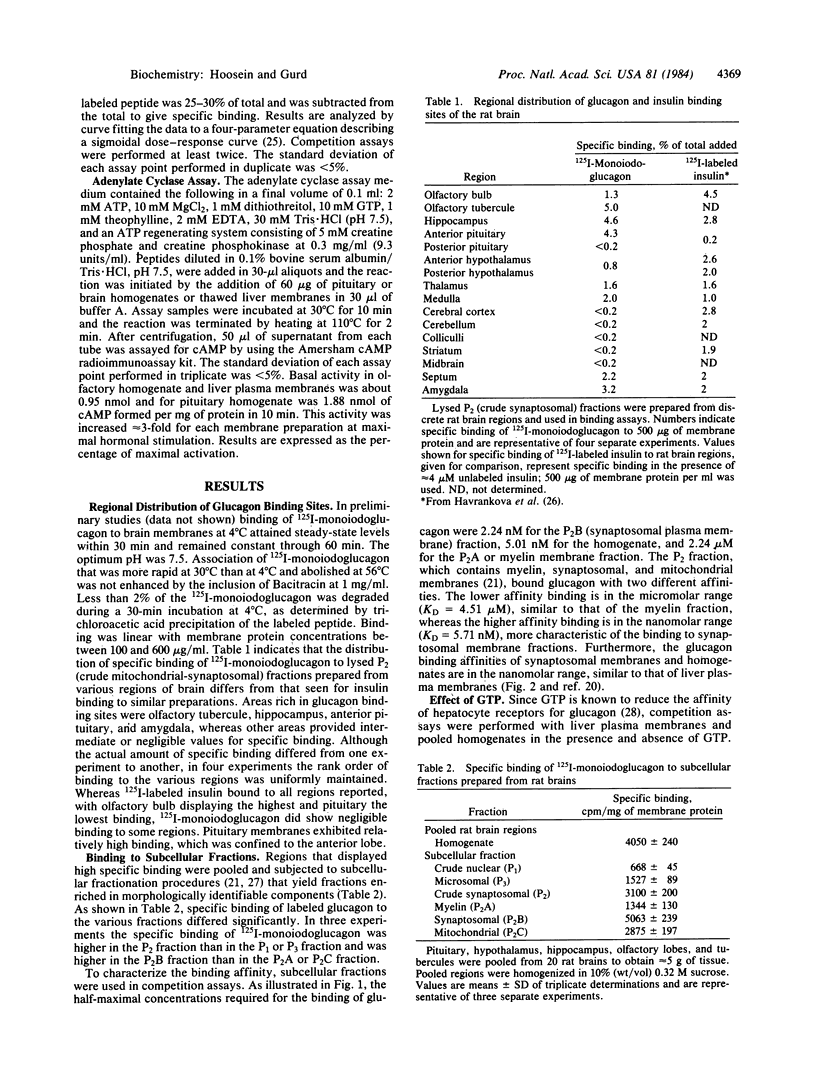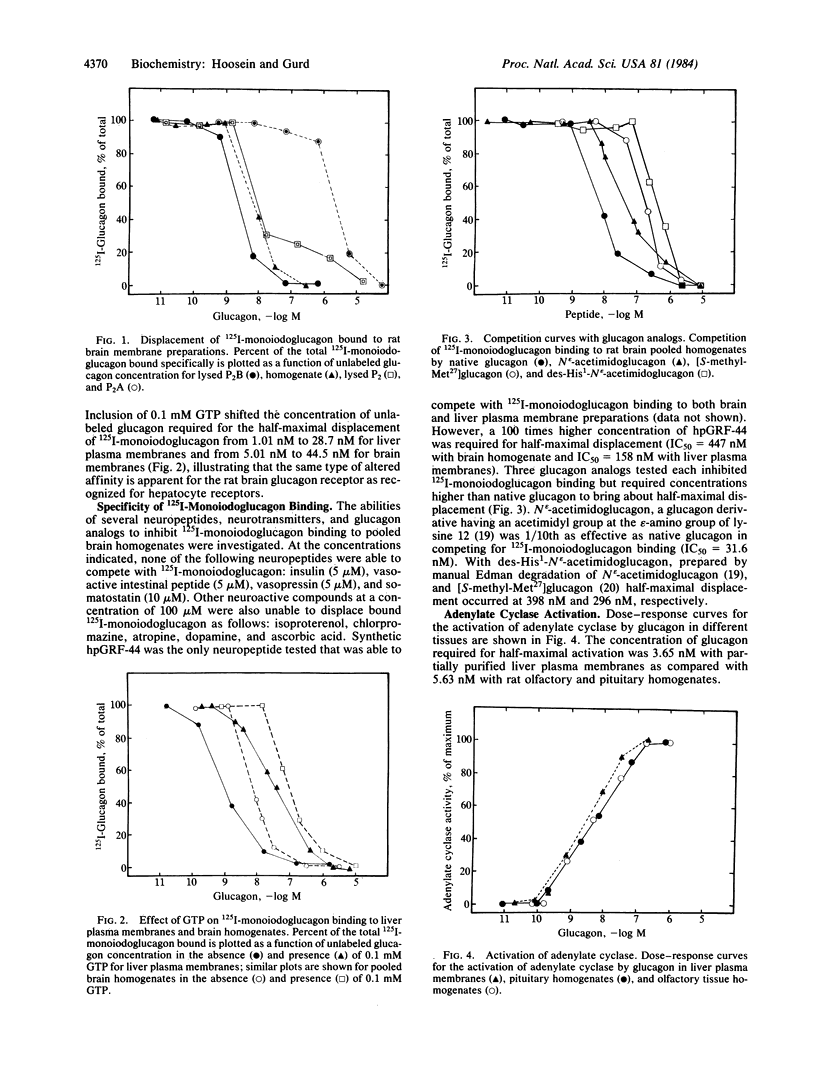Abstract
The binding of radiolabeled glucagon to rat brain membranes was investigated. Regional distribution studies indicate higher specific binding of 125I-labeled monoiodoglucagon to olfactory tubercule, hippocampus, anterior pituitary, and amygdala membranes, with somewhat lower binding to membranes from septum, medulla, thalamus, olfactory bulb, and hypothalamus. 125I-labeled glucagon bound to rat brain synaptic plasma membrane fractions with high affinity (KD = 2.24 nM). Specific binding was greater to synaptosomal membrane fractions relative to myelin, mitochondrial nuclear, or microsomal fractions. Inclusion of 0.1 mM GTP in the binding assay reduced the glucagon binding affinity (KD = 44.5 nM). Several neuropeptides and other neuroactive substances tested did not affect binding of labeled glucagon to brain membranes. Three different glucagon analogs inhibited labeled glucagon binding. Synthetic human pancreatic growth hormone-releasing factor, hpGRF-44, also inhibited binding, although the concentration required for half-maximal displacement was 100-fold higher than for native glucagon. Addition of glucagon to brain membranes resulted in approximately equal to 3-fold maximal activation of adenylate cyclase over basal levels. Glucagon at a concentration of 4.74 nM was required for half-maximal activation of pituitary membrane adenylate cyclase. These findings provide evidence for rat brain binding sites that respond to the pancreatic form of glucagon and can transduce this binding into the activation of adenylate cyclase.
Full text
PDF




Selected References
These references are in PubMed. This may not be the complete list of references from this article.
- Abe H., Kato Y., Chiba T., Taminato T., Fujita T. Plasma immunoreactive somatostatin levels in rat hypophysial portal blood: effect of glucagon administration. Life Sci. 1978 Oct 23;23(16):1647–1653. doi: 10.1016/0024-3205(78)90461-7. [DOI] [PubMed] [Google Scholar]
- Bataille D., Coudray A. M., Carlqvist M., Rosselin G., Mutt V. Isolation of glucagon-37 (bioactive enteroglucagon/oxyntomodulin) from porcine jejuno-ileum. Isolation of the peptide. FEBS Lett. 1982 Sep 6;146(1):73–78. doi: 10.1016/0014-5793(82)80708-4. [DOI] [PubMed] [Google Scholar]
- Bell G. I., Santerre R. F., Mullenbach G. T. Hamster preproglucagon contains the sequence of glucagon and two related peptides. Nature. 1983 Apr 21;302(5910):716–718. doi: 10.1038/302716a0. [DOI] [PubMed] [Google Scholar]
- Conlon J. M., Samson W. K., Dobbs R. E., Orci L., Unger R. H. Glucagon-like polypeptides in canine brain. Diabetes. 1979 Jul;28(7):700–702. doi: 10.2337/diab.28.7.700. [DOI] [PubMed] [Google Scholar]
- DeLean A., Munson P. J., Rodbard D. Simultaneous analysis of families of sigmoidal curves: application to bioassay, radioligand assay, and physiological dose-response curves. Am J Physiol. 1978 Aug;235(2):E97–102. doi: 10.1152/ajpendo.1978.235.2.E97. [DOI] [PubMed] [Google Scholar]
- Dorn A., Bernstein H. G., Hahn H. J., Kostmann G., Ziegler M. Regional distribution of glucagon-like immunoreactive material in the brain of rats and sand rats. An immunohistochemical investigation. Acta Histochem. 1980;66(2):269–272. doi: 10.1016/S0065-1281(80)80012-2. [DOI] [PubMed] [Google Scholar]
- Dorn A., Rinne A., Bernstein H. G., Hahn H. J., Ziegler M., Dammert K. Immunoreactive glucagon in neurons of various parts of the human brain. Demonstration by immunofluorescence technique. Acta Histochem. 1981;69(2):243–247. doi: 10.1016/S0065-1281(81)80035-9. [DOI] [PubMed] [Google Scholar]
- England R. D., Jones B. N., Flanders K. C., Coolican S. A., Rothgeb T. M., Gurd R. S. Glucagon carboxyl-terminal derivatives: preparation, purification, and characterization. Biochemistry. 1982 Mar 2;21(5):940–950. doi: 10.1021/bi00534a020. [DOI] [PubMed] [Google Scholar]
- Flanders K. C., Mar D. H., Folz R. J., England R. D., Coolican S. A., Harris D. E., Floyd A. D., Gurd R. S. Semisynthetic derivatives of glucagon: (des-His1)N epsilon-acetimidoglucagon and N alpha-Biotinyl-N epsilon-acetimidoglucagon. Biochemistry. 1982 Aug 31;21(18):4244–4251. doi: 10.1021/bi00261a010. [DOI] [PubMed] [Google Scholar]
- GRAY E. G., WHITTAKER V. P. The isolation of nerve endings from brain: an electron-microscopic study of cell fragments derived by homogenization and centrifugation. J Anat. 1962 Jan;96:79–88. [PMC free article] [PubMed] [Google Scholar]
- Havrankova J., Roth J., Brownstein M. Insulin receptors are widely distributed in the central nervous system of the rat. Nature. 1978 Apr 27;272(5656):827–829. doi: 10.1038/272827a0. [DOI] [PubMed] [Google Scholar]
- Krieger D. T., Martin J. B. Brain peptides (first of two parts). N Engl J Med. 1981 Apr 9;304(15):876–885. doi: 10.1056/NEJM198104093041505. [DOI] [PubMed] [Google Scholar]
- Laburthe M., Amiranoff B., Boige N., Rouyer-Fessard C., Tatemoto K., Moroder L. Interaction of GRF with VIP receptors and stimulation of adenylate cyclase in rat and human intestinal epithelial membranes. Comparison with PHI and secretin. FEBS Lett. 1983 Aug 8;159(1-2):89–92. doi: 10.1016/0014-5793(83)80422-0. [DOI] [PubMed] [Google Scholar]
- Lorén I., Alumets J., Håkanson R., Sundler F., Thorell J. Gut-type glucagon immunoreactivity in nerves of the rat brain. Histochemistry. 1979 Jul 11;61(3):335–341. doi: 10.1007/BF00508455. [DOI] [PubMed] [Google Scholar]
- Markwell M. A., Haas S. M., Bieber L. L., Tolbert N. E. A modification of the Lowry procedure to simplify protein determination in membrane and lipoprotein samples. Anal Biochem. 1978 Jun 15;87(1):206–210. doi: 10.1016/0003-2697(78)90586-9. [DOI] [PubMed] [Google Scholar]
- McGovern S., Maguire M. E., Gurd R. S., Mahler H. R., Moore W. J. Separation of adrenergic and cholinergic synaptosomes from immature rat brain. FEBS Lett. 1973 Apr 15;31(2):193–198. doi: 10.1016/0014-5793(73)80101-2. [DOI] [PubMed] [Google Scholar]
- Neville D. M., Jr Isolation of an organ specific protein antigen from cell-surface membrane of rat liver. Biochim Biophys Acta. 1968 Apr 9;154(3):540–552. doi: 10.1016/0005-2795(68)90014-7. [DOI] [PubMed] [Google Scholar]
- O'Donohue T. L., Charlton C. G., Miller R. L., Boden G., Jacobowitz D. M. Identification, characterization, and distribution of secretin immunoreactivity in rat and pig brain. Proc Natl Acad Sci U S A. 1981 Aug;78(8):5221–5224. doi: 10.1073/pnas.78.8.5221. [DOI] [PMC free article] [PubMed] [Google Scholar]
- Peterfreund R. A., Vale W. High molecular weight somatostatin secretion by cultured rat brain cells. Brain Res. 1982 May 13;239(2):463–477. doi: 10.1016/0006-8993(82)90522-4. [DOI] [PubMed] [Google Scholar]
- Propst F., Moroder L., Wünsch E., Hamprecht B. The influence of secretin, glucagon and other peptides, of amino acids, prostaglandin endoperoxide analogues and diazepam on the level of adenosine 3',5'-cyclic monophosphate in neuroblastoma x glioma hybrid cells. J Neurochem. 1979 May;32(5):1495–1500. doi: 10.1111/j.1471-4159.1979.tb11090.x. [DOI] [PubMed] [Google Scholar]
- Rehfeld J. F. Localisation of gastrins to neuro- and adenohypophysis. Nature. 1978 Feb 23;271(5647):771–773. doi: 10.1038/271771a0. [DOI] [PubMed] [Google Scholar]
- Robbins R. J., Sutton R. E., Reichlin S. Effects of neurotransmitters and cyclic AMP on somatostatin release from cultured cerebral cortical cells. Brain Res. 1982 Feb 25;234(2):377–386. doi: 10.1016/0006-8993(82)90877-0. [DOI] [PubMed] [Google Scholar]
- Rodbell M., Krans H. M., Pohl S. L., Birnbaumer L. The glucagon-sensitive adenyl cyclase system in plasma membranes of rat liver. IV. Effects of guanylnucleotides on binding of 125I-glucagon. J Biol Chem. 1971 Mar 25;246(6):1872–1876. [PubMed] [Google Scholar]
- Sasaki H., Ebitani I., Tominaga M., Yamatani K., Yawata Y., Hara M. Glucagon-like substance in the canine brain. Endocrinol Jpn. 1980 Dec;27 (Suppl 1):135–140. doi: 10.1507/endocrj1954.27.supplement_135. [DOI] [PubMed] [Google Scholar]
- Shimatsu A., Kato Y., Matsushita N., Katakami H., Yanaihara N., Imura H. Effects of glucagon, Neurotensin, and vasoactive intestinal polypeptide on somatostatin release from perifused rat hypothalamus. Endocrinology. 1982 Jun;110(6):2113–2117. doi: 10.1210/endo-110-6-2113. [DOI] [PubMed] [Google Scholar]
- Shimatsu A., Kato Y., Matsushita N., Ohta H., Kabayama Y., Imura H. Glucagon-induced somatostatin release from perifused rat hypothalamus: calcium dependency and effect of cysteamine treatment. Neurosci Lett. 1983 Jun 30;37(3):285–289. doi: 10.1016/0304-3940(83)90445-7. [DOI] [PubMed] [Google Scholar]
- Solter M., Sekso M. Effect of fasting on posthyperglycemic glucose homeostasis in obesity--experimental model for reactive hypoglycemia. Exp Clin Endocrinol. 1983 Jan;81(1):33–40. doi: 10.1055/s-0029-1210204. [DOI] [PubMed] [Google Scholar]
- Spiess J., Rivier J., Vale W. Characterization of rat hypothalamic growth hormone-releasing factor. Nature. 1983 Jun 9;303(5917):532–535. doi: 10.1038/303532a0. [DOI] [PubMed] [Google Scholar]
- Tager H. S., Markese J. Intestinal and pancreatic glucagon-like peptides. Evidence for identity of higher molecular weight forms. J Biol Chem. 1979 Apr 10;254(7):2229–2233. [PubMed] [Google Scholar]
- Tager H., Hohenboken M., Markese J., Dinerstein R. J. Identification and localization of glucagon-related peptides in rat brain. Proc Natl Acad Sci U S A. 1980 Oct;77(10):6229–6233. doi: 10.1073/pnas.77.10.6229. [DOI] [PMC free article] [PubMed] [Google Scholar]
- Tatemoto K., Carlquist M., McDonald T. J., Mutt V. Isolation of a brain peptide identical to the intestinal PHI (peptide HI). FEBS Lett. 1983 Mar 21;153(2):248–252. doi: 10.1016/0014-5793(83)80617-6. [DOI] [PubMed] [Google Scholar]
- Tominaga M., Ebitani I., Marubashi S., Kamimura T., Katagiri T., Sasaki H. Species difference of glucagon-like materials in the brain. Life Sci. 1981 Oct 12;29(15):1577–1581. doi: 10.1016/0024-3205(81)90259-9. [DOI] [PubMed] [Google Scholar]
- Triepel J., Elger K. H., Forssmann W. G. Glicentin-immunoreactive perikarya and varicosities in the guinea pig central nervous system. Neurosci Lett. 1982 Jun 30;30(3):285–289. doi: 10.1016/0304-3940(82)90414-1. [DOI] [PubMed] [Google Scholar]
- Unger R. H., Orci L. Glucagon and the A cell: physiology and pathophysiology (first two parts). N Engl J Med. 1981 Jun 18;304(25):1518–1524. doi: 10.1056/NEJM198106183042504. [DOI] [PubMed] [Google Scholar]
- van Houten M., Posner B. I. Insulin binds to brain blood vessels in vivo. Nature. 1979 Dec 6;282(5739):623–625. doi: 10.1038/282623a0. [DOI] [PubMed] [Google Scholar]


